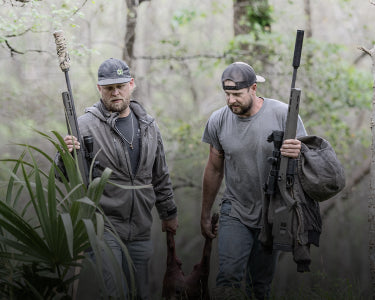Spring Turkey Hunting Preparation
Every year in late winter, as cabin fever begins to set in, we start to think about spring turkey season. As Mother Nature allows, we gradually begin to disc plots, frost-seed our clover and chicory and use prescribed fire on our native warm-season grasses. Fire—in addition to management practices such as food plots, timber management and predator control—can dramatically increase turkey activity on your property.
Fire suppresses unwanted plants and weeds, increases the palatability by encouraging new tender growth and improves wildlife habitat. In early spring, turkeys find these areas to be a great source of food.
While predators such as coyotes and bobcats are much easier to avoid in freshly burned warm-season grasses, mature toms find these burns irresistible—they are incredible places to seek out hens and put on a show, fans out, in full strut.

The Hunt
A few days into the spring 2021 turkey season, we found ourselves set up on an area we had burned several weeks prior. While driving into the property, we located a big tom strutting in the middle of the burn. He had a single hen with him but she was giving him the cold shoulder as she fed along the edge of a creek.
Several fingers of mature oaks separated us from the birds and we used them to our advantage as we cut the distance using woodlots for cover. A small pond at the edge of the woods meant the end of the road for us. We had cut the distance as much as possible and now only a few hundred yards separated us from where we had seen the strutting tom just 30 minutes earlier.
I crawled across the burned grasses to get the decoys in place—hen and jake decoys were now easily visible from nearly every direction. As I set up, questions began to flood my head.
Is the tom still in this area? Are there any wild turkeys in the area? Will he hear my calling in the wind? Which way will he come from?
We settled into a large clump of partially burned cedars and began to call. I was slightly forward of my buddy, Chris Walls, who had volunteered to run the camera that day. Several minutes went by with no movement and no response from the tom we had seen earlier.
After nearly 30 minutes of periodic calling, I heard a faint gobble in the distance. Chris and I shared a quick glance to confirm that we had both heard what we thought we had heard. The tom was a long way away and had quite a distance to cover. Yet, still he had answered my call and that alone boosted our spirits considerably.
After that first gobble, things happened fast. As I called, the tom would immediately respond and occasionally cut me off. All the while, we could tell he was getting close with each subsequent gobble.
The bird had committed and, within just a few minutes, had closed the distance by several hundred yards. I had to shift positions slightly. The tom decided he was coming right over the top of the pond dam to look for the hen that was making all of that sweet racket.
I heard him before I saw him. Although the tom neared, he remained hidden—the unmistakable sound of drumming just over the lip of the pond dam meant that he was close…real close!

Finally, the glimpse of a patriotic red, white and blue head over the edge of the pond damn made my heart race even faster! One last gobble and the body language of the old tom completely changed. He had seen the decoys! The tom was now focused on fighting his competition.
He cruised into the decoys at a brisk pace, dragging his wingtips and puffing out his chest. He passed by the Avian hen decoy without a second look and immediately began to beat up on the poor jake with well-placed wings and spurs!
Lining Up the Shot
As he continued, I stared intently, directly down my shotgun barrel at the unsuspecting gobbler. The Sightmark Wolverine’s bright red-dot reticle followed the tom’s head as he danced around the jake. Chris whispered the confirmation I needed that he was on the bird and rolling.
While Chris was ready, I was not. I needed to let him clear the decoy just a bit to avoid putting pellets in my plastic prizefighter!
The click of the safety and a slight squeeze of the trigger left the tom laying on the ground between the decoys. A quick high-five with my cameraman and I ran out to gather what turned out to be another incredible bird off one of our Oklahoma properties.
Property management and the right equipment played a huge role once again in the form of another successful spring turkey hunt. They don’t always end with smiles and high-fives but they do always end in an education. Make an effort to learn something every time you are out in the woods or on the water and it is sure to make you more successful in the future.
Wild turkey management, and wildlife management overall, is eminently important. Spring turkey hunters should always follow hunting regulations which includes observing bag limits, obtain turkey tags and having a proper hunting license, as well as adhering to public lands etiquette if you’re not on private property.

About Brian
Brian is originally from Albuquerque, New Mexico, but has spent most of his life in the Oklahoma City area. He achieved a life-long goal of becoming a firefighter in 2003 and is now a part of the Oklahoma City Fire Department as a Lieutenant. His love for the outdoors, hunting and fishing began at a very young age thanks to a family who shared that same interest.
He grew up with a fishing pole in hand and began hunting with his dad around the age of 6. At the age of 14, he received his first hunting bow for Christmas and his love for bowhunting was born. He has been bowhunting for over 25 years and has had the privilege of harvesting many animals.
While he spends most of his time hunting and fishing, reloading also ranks high on his list of hobbies. He is married to a very understanding wife and enjoys every minute they spend together.




